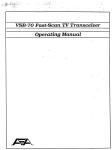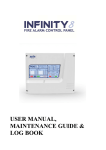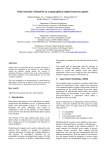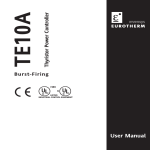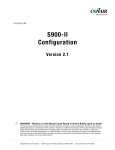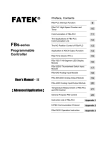Download Milltronics LevelGenie Specifications
Transcript
CONTENTS TITLE SECTION PAGES I GENERAL INFORMATION l-l II SPEICIFCATIONS 2-1, 2-2 III THEORY OF OPERATION 3-1, 3-2,3-3,3-4 IV INSTALLATION 4-1, 4-2,4-3 V CALIBRATION AS A: 5-1, 5-2,5-3,5-4 5-5 HI HI LO PUMP LO ALARM HI ALARM LO ALARM CONTROL VI MISCELLANEOUS 6-l VII MAINTENANCE AND OVERHAUL 7-l DRAWINGS FIG. 1 OUTLINE AND MOUNTING DIMENSIONS FIG. 2 TRANSDUCER INSTALLATION FIG. 3 EASILY AVOIDABLE INSTALLATION ERRORS FIG. 4 OUTLINE AND CABLE CONNECTION DIAGRAM FIG. 5 FIG.5b FIG. 6 RELAY ACTION TRANSDUCER DO'S AND DON'TS TRANSCEIVER SCHEMATIC FIG. 7 DIGITAL PROCESSING SCHEMATIC . I. GENERAL INFORMATION The Milltronics Level Genie Ultrasonic System is an entirely "Solid State Package", designed to provide contact closure at accurately determined levels of liquids and solids up to 10 feet (3M) from the transducer. This system consists of only two elements, ultrasonic transducer and cabineted electronics, neither of which require contact with the material to be measured. Seperation between transducer and electronics may reach 600 feet (183M). The Level Genie measures the time required for a transmitted ultrasonic pulse to complete a round trip from the transducer to the sensed material and back. This measurement is converted electronically into distance and then compared with the two independently adjustable set points. Depending on the programming module employed, this comparison actuates the output relays whose 10 amp 115 VAC contacts indicate material level status. Programming modules, available in easily changeable plug-in form, allow the Level Genie to operate as; an independent high and low alarm, as two high alarms, as two low alarms or as a pump control. In addition to the normal set point hysterisis, selectable time delays of 3 or 10 seconds may be introduced via a convenient P.C.B. mounted switch. The unique digital noise rejection circuitry of the Level Genie allows placement of the electronics in motor control centers and direct interlocking of primary devices via the contact outputs. l-l II. SPECIFICATIONS Power Required 115 VAC + 10% 40 Hz at 6VA Transducer Barium Titanate element C.P.V.C. outer housing and polyurethane radiating face. Optional face materials are available. Transducer rated for Class I, Groups A, B, C, D, &'Class II Groups F & G. Range 1.5 to 10.0 feet 0.45 to 3.1 meters output Two (2) Form C, S.P.D.T. contacts rated 10A 115VAC non-inductive Set Points Two (2) independently adjustable throughout the range Set Point Hysterisis 0.5 inch per ft. of range when in alarm mode Response Time 0.5 sec. without time delay Time Delay Selectable 3 or 10 seconds Repeatability Better than 0.1% (l/16"' on 5' range or l/8" on 10' range) Temperature Effects Setpoint varies -0.17% of range/°C deviation from calibration temperature Temperature Range Electronics -2OO°C to +60°C '-5 t o'+140°F) Transducer -40°C to +93°C (-40 to +200°F) Separation Maximum distance from transducer to electronics is 183M (600 ft.) using RG-62U co-axil cable 2-l Operating Modes* 1. 2. 3. 4. Enclosure Nema 12 standard Nema 4 optional Weight Transducer - 2 lbs. Pump up/down Hi-Lo alarm Hi-Hi alarm Lo-Lo alarm One programming module supplied with unit. Additional modules available as options. Enclosure & Electronics - 12 lbs. 2-2 III. THEORY OF OPERATION TRANSCEIVER CIRCUITRY 1. General Description The transceiver uses a single tuning section which is time-shared between the transmitting and receiving functions. Three co-ordinatinq signals, generated in conjunction with the repetition rate signal, control the transceiver switching it between transmitting and receiving modes. 2. As a Receiver Echo signals, generated when an echo strikes the face of the transducer, are presented to the receiver input via R1. Diodes D1 and D2 protect the receiver input from the out-going transmit pulse by limiting signals at the receiver input to plus or minus one diode drop. Q1 amplifies the echo signal and presents it to the base (Q2 is associated with the transmit function of 03 via C3. and will be discussed later) Q3 provides two receiver functions. Firstly, it is a tuned amplifier operating in conjunction with the tank circuit formed by the inductance of the primary winding of Tl and C5. Secondly, Q3 provides time varying gain to overcome transducer ringing which occurs immediately after transmittinq. Just after transmitting, when ringing is most severe, Q3 is driven by very strong signals. These signals cause a buildup of voltage at the emitter of Q3. R9 and C6 have been chosen so that the excess voltage at the emitter of Q3 decays away at a rate which matches the decay of ringing within the transducer. During the first 1.5 milliseconds after the transmit pulse is sent, the receiver is rendered in-operative by a blanking signal. By the time the blanking signal is removed the decay process is well under way. Q3 operates as an amplifier whose gain increases with time in a way that ensures it is always insensitive to transducer ringing but still sensitive enough to respond to any strong echo which may be returned from a nearby target. 3-l Q6 and Q7 provide additional amplification. Q7 also serves as a detector charging C9 with the positive halfcycles of the received signal. Q8 is turned on during the blanking period to prevent C9 from accumulating any charge. Thereby precluding any receiver output during this time period, When the voltage on C9 reaches about 1 volt, Q9 turns on and the voltage at the collector of Q9 falls to zero signifying reception of an echo. The network formed by D3, R25, and Cl1 provides a delayed receiver output which responds only to signals of a half millisecond duration or longer. Noise spikes of short duration are therefore ignored. 3. As a Transmitter Q2 and Q5 control the change over from receiver to transmitter. During transmit time, Q2 is turned on dissabling Q3 and Q5 is turned off releasing Q4 to operate in place of Q3. Q4 and Q6 are in a closed, positive feedback loop which oscillates at the frequency to which the primary of Tl and C5 are tuned ie. at the receiver's operating frequency. Two gates of IC-7 form a monostable multivilrator. During transmit time, pin 9 of IC-7 is held low allowing the monostable to product a string of pulses each a little less than a half cycle of transmit frequency but spaced exactly a half cycle apart. QlO, Qll, and Q12 amplify these pulses in class C fashion and apply them to the primary of transformer T2. T2 increases the signal to about 350V peak-to-peak to drive the transducer. 3-2 ECHO PROCESSING LOGIC 1. General Description The digital echo processor establishes the necessary timing and limit functions. Coincidently, statistical techniques are employed to discriminate against response to spurious noise inputs. 2. Timing & Limit Generation IC 3-1, IC 3-2 and IC l-l form a typical hybrid monstable multivibrator. This type of pulse generator is extremely stable over a wide range of temperature and/or bus variations. Repetition rate generator ICl-3 triggers the timing monostables which generate the following functions; pulse width, blanking, the'NEAR' setpoint, the'FAR'setpoint, and limit. (Maximum Range) Switch SWl, the maximum range switch, allows the range to extend to either 5 feet or 10 feet. 3. Alarm Point Recognition IC 5-1, IC 5-2, IC 6-l and IC 6-2, are C-MOS NOR gates. Each gate accepts two inputs, the processed echo and one of the timing functions. The order in which the timing functions are connected to the gate inputs determines the mode of operation of the unit, ie. Hi-Lo alarm, Lo-Lo alarm. Plug-in programming modules allow easy field modification. Another toggle on switch SW1 allows introduction of either a 3 second or 10 second delay on alarm. Moving the third toggle (SW1) from run to calibrate removes these delays. Resistors R62 and R65 about IC 2-3 and IC 2-4 provide alarm point hysterisis of 0.5 in. (12.5mm) per foot of range. 3-3 4. Digital Echo Processing Various digital, statistically based, processing techniques are employed to render the Level Genie immune to random noise inputs. a. Echo width detection ignores short duration signals such as line transients and most SCR noise. b. Echo reception logic accepts only one echo per transmit sequence. C. d. Digital windows are established at the"NEAR'and 'FAR'setpoints and only echoes occurring in these zones are recognized. It requires three valid echoes in three successive transmit sequences in order to trigger an output response. 3-4 IV. 1. INSTALLATION Electronic Package The electronic circuits of the Level Genie Ultrasonic Level Switch are contained on a single printed circuit motherboard. A Nema 12 enclosure is supplied. Refer to Fig. 1 for outline and mounting dimensions. Separate 1/2" conduits should be installed for the power wiring and the transducer cable. The transducer cable must not be installed in a conduit with other wiring. Fig. 3 indicates proper terminal connections for the electronics. Note, that the power input must include a good electrical ground. Since the Level Genie is designed for continuous operation, a power switch has not been provided. If one is desired it may be included in the external power circuit. 2. Pre Start-Up Checks (A) Unit Synchronization To avoid cross talk between multiple units located in the same panel or with common transducer runs, the units must be (They must transmit simultaneously). synchronized. To synchronize any number of units, series connect terminal 10,marked "SYNC", with jumpers from unit to unit. (B) Program Module Be sure the program module is installed in the correct (With the rounded corner toward the top of the orientation. circuit board). (C) Switch SW1 The "RUN - CAL" toggle should be in the "CAL" position to 4-1 5. Alarm Anti-Latch Circuit (stab select at A position) In some applications, the Level Genie is used to detect an object instead of a material level. Usually, a HIGH-HIGH program module can be used: HIGH alarm to detect the object and in the absence of the object, echoes received from any target out of HIGH alarm zone will reset the system. However, if there is no target to intersect the ultrasonic beam within 10 feet (the maximum range of the Level Genie), no echo will be received. In this case, the alarm anti-latch circuit will unlatch both alarm circuits in less than one second and get the system ready for the next detection. This situation may also happen when there is an alarm in a dusty area and suddenly the material level is moved out of the alarm region so fast that it causes the loss of echo. The alarm anti-latch circuit will again unlatch the alarm (ie. reset the system), when the loss of echo is more than one second. (Note:. the minimum delay on the alarms is about 3 seconds). The system reverts to normal operation under one of three following conditions: a. b. c. Whenever a regular echo is being received. Whenever the pump program module is installed. When stab select is changed from A to B position which is the standard position (without anti-latch circuit). 3-5 disable the alarm time delays while calibrating. The "10 ft. - 5 ft.'" toggle should be in the appropriate position reflecting the desired operating range. 3. Transducer The ST25 series transducers have an outer housing of chlorinated polyvinyl chloride (CPVC) and a radiating face of polyurethane. These materials have excellent resistance to a wide range of corrosives but may be damaged by ketones, aromatics and some chlorinated hydrocarbons. Alternate materials are available for these environments. The operating range of the transducer is between -4O°C to +93°C (-400°F to +200°F). These temperatures must not be exceeded at the face of the transducer or permanent damage may result. The ST-25 transducer is generally mounted at the top of the vessel with its'radiating surface aimed directly down at the surface of the material being measured. The transducer is provided with a 1" NPT nipple for direct attachment. See Fig. 2 for transducer dimensions and typical mounting. a. Mount the transducer at least eighteen (18) inches above the highest level the material will reach in the vessel directly beneath the transducer. This minimum distance between material and transducer must be provided for proper operation of the system at high material level. b. Locate the transducer as far as possible from the point the material enters the vessel to minimize interference from sonic noise generated by the incoming material and to prevent the material from falling or splattering into the sound path between the transducer and the material being measured. C. Do not locate the transducer directly above any object 4-2 within the vessel such as a supporting beam which would interfere with the sound path between the transducer and the material being measured. NOTE Ultrasonic sound waves are radiated from the face of the Transducer within a cone of approximately 8 degrees. The Level Genie System depends upon these sound waves reaching the surface of the material to be measured and being reflected back along this same "sound path". Any object within this "sound path" that reflects an "echo" will interfere with the measurement of the material level. For practical purposes the transducer should be located one half bin radius from the side wall (assuming a center fill bin.1 d. Position the transducer so that its radiating surface is aimed directly at the material to be measured. When measuring liquids, the radiated beam or sound path must be perpendicular to the liquid surface. 4-3 V. CALIBRATION Before applying line power to the Level Genie, ensure that all pre-start-up checks (Section IV) have been completed. 1. General Alarm Calibration It is usually expedient to calibrate the Level Genie before installation, thereby avoiding the necessity of changing bin levels to set the trip points. After installation a spare transducer serves as an invaluable tool for checking calibration. a. b. c. d. Set mode toggle (SWl) to "CAL" Set the maximum range toggle (SWl) to the appropriate 5 feet or 10 feet maximum range. Set the NEAR potentiometer fully counter clockwise. Set the FAR potentiometer fully clockwise. This (Steps b & c) sets the trip points with "NEAR" at minimum range and "FAR" at maximum range, refer to FIG. 5. SPECIFIC CALIBRATION OF HI-LO PROGRAM MODULE (OMIT IF OTHER PROGRAM USED) e. With the transducer placed at a distance from a fixed target, representative of the low level, adjust the "FAR" potentiometer counter clockwise until RL2 just drops out. (LED2 will extinguish) The Low Level alarm is now calibrated. f. With the transducer placed at a distance from a fixed target, representative of the desired high setpoint, adjust the "NEAR" potentiometer clockwise until RLl just drops out (LED1 will extinguish) The high alarm is now calibrated. 5-l SPECIFIC CALIBRATION OF HI-HI PROGRAM MODULE (OMIT IF OTHER PROGRAM USED) 9. With the transducer placed at a distance from a fixed target representative of the high level, farthest from the transducer, adjust the "FAR" potentiometer counter clockwise until LED2 comes on. Then turn the control slowly clockwise until LED 2 extinguishes (Relay 2 drops out). h. Set the higher of the two high alarm points as follows. Adjust the target to sensor distance to correspond to the material level at the highest setpoint. Turn the "NEAR" setpoint control clockwise until LED 1 extinguishes (Relay 1 drops out) SPECIFIC CALIBRATION OF LO-LO PROGRAM MODULE (OMIT IF OTHER PROGRAM USED) i. With the transducer placed at a distance from a fixed target representative of the low level, farthest from the transducer, adjust the "FAR" potentiometer counter clockwise until LED 2 extinguishes (Relay 2 drops out). j. Set the higher of the two low alarm points as follows. Adjust the target to sensor distance to correspond to the material level at the highest setpoint. Turn the "NEAR" setpoint control clockwise until LED 1 illuminates, then turn the control slowly counter clockwise until LED 1 extinguishes (Relay 1 drops out). COMMENTS APPLICABLE TO ALL ALARM PROGRAM MODULES Delayed Response Some applications may require time delay on "alarm". Switching the mode toggle of SW1 from "CAL" to "RUN" introduces 5-2 a delay in output response by 3 seconds or 10 seconds depending on the position of the delay toggle. I M P O R T A N T Rotating the"NEAR"and"FAR"setpoints in the direction of the arrows (on the PCB) brings the trip points closer together. Caution must be exercised not to cross these controls. The NEAR setpoint should always be set to a higher level than the FAR setpoint. USING ONLY ONE OF THE DUAL ALARMS As a precaution, to avoid having the NEAR and FAR settings crossed, use only the FAR setpoint for single alarm operation. Turn the NEAR setpoint fully counter clockwise. HYSTERISIS Approximately 0.5 in. (1.25cm) of hysterisis per foot of range is provided. Thus, a high alarm 8 feet from the transducer has a 4 inch deadband. That is, the material would have to drop to 8.33 feet before the alarm would clear. 5-3 ' 2. Pump Up/Down Program Module - - - r Actuation In "pump down" operation, the liquid level must rise above the NEAR setpoint to de-energize the relays. Once this condition is met they are locked in the de-energized state, until the level drops below the FAR setpoint. Thus, rising above the near setpoint sets the control state until a low or far level is achieved. Similarly, for "pump up" operation, the level must drop below the far setpoint, which sets the relay state (energized) until the level exceeds the near setpoint. Pump Module Calibration It is usually expedient to calibrate the Level Genie before installation thereby avoiding the necessity of changing tank levels to set the trip points. After installation a spar transducer serves as an invaluable tool for calibration check. a. b. Set mode toggle (SWl) to "CAL". Set maximum range toggle (SW11 to the appropriate 5 feet or 10 feet maximum range. 5-4 c. a. e. f. Set the "NEAR" potentiometer 1/4 turn from fully counter clockwise. Set the "FAR" potentiometer fully clockwise. This sets the trip point at maximum range. Move the transducer toward the target until the LED indicators extinguish (relays dropped out). Then, with the distance between the transducer and target corresponding to the desired low level, adjust the "FAR" setpoint, slowly counter clockwise until the LED indicators illuminate (relays energized). The lower pump limit is now established. Set the "NEAR" setpoint control fully counter clockwise. Move the transducer forward to a distance representative of the "high" level. Adjust the "NEAR" set point slowly clockwise until the LED indicators extinguish (relays drops out). The high pump limit is now established. OTHER SETTINGS Generally, pump modules are run with the mode switch in "CAL" position, as there is no advantage and possible disadvantage to using time delay in pumping applications. I M P O R T A N T The Level Genie is "blind" to levels (closer to the transducer than 18" and farther from the transducer than 30" below the low level control point.) When placing the Level Genie into service, it is imperative that the liquid level be within this limitation. This is an initial consideration only. 5-5 VI. MISCELLANEOUS Checks to make before pushing the Panic Button SYMPTOM Unable to calibrate one setpoint CAUSE Program module offset in socket or inverted. High Alarm apparently inoperative 'NEAR'setpoint set too close to minimum range or within blanking range. (Turn near setpoint in direction of arrow) Erratic & Inability to calibrate 'NEAR'and'FAR-setpoint controls crossed (low set point placed above the high setpoint) Alarm settings unstable when mode switch placed in "run" position Time Delay excessive enabling the level to enter the blanked zone before alarming Unable to calibrate Low alarm Maximum range set to short (Switch SW1) 6-l VII. MAINTENANCE This equipment requires very little maintenance due to its solid-state circuitry. However, a program of periodic preventive maintenance should be initiated. This should include regular inspection, general cleaning, transducer face inspection, overall system performance checks, and standard good-housekeeping practices. A periodic inspection of the transducer is recommended in some applications, at which time any build-up of material on the transducer face should be removed. WARNING: TURN POWER OFF BEFORE ATTEMPTING TO CLEAN CHASSIS. The chassis is best cleaned with a vacuum cleaner or a clean, dry cloth. Remove all layers of accumulated dust from printed-circuit board components. Check all electrical contacts for corrosion and wear. 7-l FIG-1 OUTLINE & MOUNTING DIAGRAM i FIG:3 EASILY AVOIDABLE INSTALLATION ERRORS. a company to be controlled by Throughout the world Milltronics has become a name respected for the high quality of its industrial process controls. The engineering and design capabilities that produce our product line are among the best to be found. You need only look at the rapidly growing involvement of our company, at the preliminary engineering and design stages of new plants as well as major plant revamps to realize the growing importance of our product line. If you want to put control of your material movement and storage on an electronically accurate basis, then Milltronics product line has the device for you. Products to accurately sense motion, level, flow and for providing closed loop control on grinding mills are just a few of our specially designed devices for the process industries. Operating installations around the world and customers who keep coming back to our factory trained applications personnel are our best salesmen. Naturally, our responsibility doesn’t end when your order is shipped. Our fully trained field service personnel are available to provide installation and training services, and our world-wide organization of agents and distributors are always close at hand. The next time you need professional know-how in materials handling do as more and more industries around the world are doing. Call us. MILLTRONICS LTD., 730 The Kingsway, Peterborough, Can. K9J 6W6 MILLTRONICS INC., 2409 Avenue ‘J’, Arlington, Texas 76011 Tel. (705) 7452431 Telex 06-962851 Tel. (817) 649-8640






























